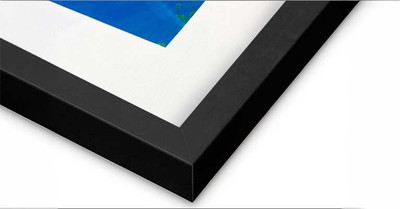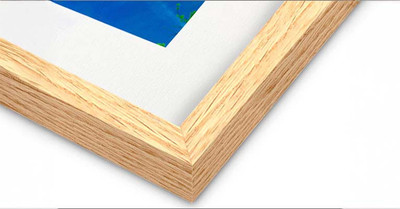
Historic Map - Garfield, NJ - 1909
Description
Birds eye view of Garfield, New Jersey 1909 / drawn and published by T. M. Fowler.
This reproduction panoramic view of Garfield, New Jersey was drawn and published by Thaddeus Mortimer Fowler in 1909. The Hackensack Clan of the Leni Lenape Tribe of Algonquin Indians lived and worked in this area where the Passaic and Saddle Rivers meet. A natural rock dam on the Passaic River may have inspired the Indians to construct their own rock dams to catch fish and eels. Some of these dams are still visible today.
When Gen. George Washington took flight from Fort Lee and Hackensack in 1776, he marched his troops over a bridge crossing the Passaic. They camped for the night and then fled to Pennsylvania. Upon their exit, local patriot John H. Post, who was only a farm lad at the time, destroyed the bridge, delaying the British troops advancing on Washington for several days.
A dam was built in the early 1800s and mills were erected along the river in what was called East Passaic. In the1860s the Saddle River Horse Car Railroad from the Passaic River to Paterson, N. J. was built to provide transportation for millworkers. Later during the Panic of 1873, this route became important to the economy of the community as future railroad funds dried up for a time.
The town in Bergen County was formed in 1873 and known then as East Passaic. The name was later changed to honor U. S. President James A. Garfield and incorporated as a borough in 1898. Eight years after this map's publishing Garfield would reach city status.
The bird's-eye view map from 1909 shows Garfield's streets, bridges and buildings. It features inset illustrations of the following:
Borough Hall.
Belmont School.
School No. 6.
First Reformed Church.
Presbyterian Church.
Factory of Passaic & Garfield Construction Co. Mfrs. of Ornamental & Building Cement Blocks.
John Karl Real Estate.
Hammerschlag Manufacturing Company.
Lotsey Toth Plaudersville Cafe.
Garfield Worsted Mills.
Materials
Archival Paper

Premium fine art paper that provides accurate color reproduction with high-contrast, high-resolution print output and maximum image permanence. A high-quality print ready for framing.
More
- Museum quality paper for high-quality fine art.
- Ultra smooth, neutral white matte finish.
- Heavy-weight 230 gsm, 9.5 mil thickness.
- Printed with pigment inks for longer print life and enhanced fade resistance.
- Pigment based Canon LUCIA inks provide smooth tones and rich colors in fine, precise detail.
Luster Photo Paper

A premium semi-gloss photo paper with a subtle texture that produces a vivid, richly detailed print. This material results in an exquisitely detailed giclee print of substantially higher quality than a standard poster.
More
- Printed on 10 mil premium luster photo paper resulting in a brilliant, colorful image with a vivid life-like quality.
- Pigment based Canon LUCIA inks provide smooth tones and rich colors in fine, precise detail.
- Inks have a lightfastness rating of over 100 years, guaranteeing minimal noticeable fading over a very long period of time.
- Printed using very high resolution source files.
- Giclee printing is superior to traditional lithography in a number of ways: colors are brighter, lasts longer, and is a higher resolution.
Canvas on Wood Rails

A canvas giclee print is mounted to wooden hanging rails placed along the top and bottom of the map. Ready to hang on the wall using the attached hanging cord. Wood rails feature a natural finish.
More
- Premium 19 mil canvas material.
- Wood rails are 1 1/8" wide, round front.
- USA sourced solid maple wood.
- High quality giclee fine art print with a lightfastness rating of over 100 years.
- Pigment based Canon LUCIA inks provide smooth tones and rich colors in fine, precise detail.
Canvas Gallery Wrap

A high quality canvas giclee print is hand stretched over a sturdy wood frame. Printed on demand and handcrafted in Seattle, WA. The canvas gallery wrap serves as a stunning piece of art ready to hang on your wall.
More
- Premium 19 mil canvas material.
- Pigment based Canon LUCIA inks provide smooth tones and rich colors in fine, precise detail.
- High quality giclee fine art print with a lightfastness rating of over 100 years.
- Durable canvas mounted to a 1" deep wood frame.
- Ready to hang with included easy-to-use hanging kit.
Framed - Black Finish

Our gallery quality frames are made of solid wood and feature optical-grade acrylic. Each framed map is printed on premium archival matte fine art paper.
More
- Printed on thick, luxurious acid-free fine art paper & dry-mounted to foam board.
- Pigment inks ensure a vivid print with amazing colors and excellent fade resistance.
- Solid wood frame with a black finish has a 1.25" face & 7/8" depth.
- Kraft paper protective backing & hanging wire installed.
Framed - Natural Oak Finish

Our gallery quality frames are made of solid wood and feature optical-grade acrylic. Each framed map is printed on premium archival matte fine art paper.
More
- Printed on thick, luxurious acid-free fine art paper & dry-mounted to foam board.
- Pigment inks ensure a vivid print with amazing colors and excellent fade resistance.
- Solid wood frame with a natural oak finish has a 1.25" face & 7/8" depth.
- Kraft paper protective backing & hanging wire installed.

Made In The USA

School Purchase Orders









